Javanese sacred places
| This article is a part of the series on |
| Indonesian mythology and folklore |
|---|
 |
|
|
Javanese sacred places are locations on the Island of Java, Indonesia that have significance from either village level through to national level as sacred, and in most cases deserve visitation—usually within the context of ziarah regardless of the ethnicity or religion of the visitor. The dominant form for many places is a sacred grave, or a place associated with persons considered to have special attributes in the past—like Wali Sanga or Royalty.
Form[edit]
The tendency has been for graves to equate to sacred places, but the full range can include (and this list is not exhaustive)
- Caves (Goa or Gua)
- Trees, or a group of trees (Pohon or Hutan)
- Mountains and volcanoes[1]
- Landscape[2]
- Springs
- Rock Outcrops
- Man made fixed structures - temples, buildings, and ruins[3]
- Kraton structures are considered sacred
- Places of rest of Javanese saints or legendary characters
In some areas in Java, the tell-tale sign that a place has been ascribed sacred or special, is either traces of burnt incense (kemenyan) or flower petals.
Terminology[edit]
Common expressions in Javanese and Indonesian for these places are:
- Pundhen - short for pepundhen
- Tempat Keramat
- Tempat Ziarah[4]
Other terms that might be used
- petilasan - traces - of ancestors.[5]
Although there is no necessary set pattern, and each individuals pilgrimage is a very personal one, even if travelling with a group.[6]
National[edit]
The graves of national and regional heroes and significant people—either of distant historic nature (the graves of the Wali Sanga or Islamic Saints of Java), or of more recent dates—national heroes of the last 100 years or so, and leaders and 'special people'.[7]
Some examples:
- Borobudur, 9th century Mahayana Buddhist Temple, a powerful symbol for Indonesia to testify for its past greatness
- Prambanan, 8th-century Hindu temple
- Menang, in Pagu sub-district of Kediri Regency, dedicated to King Jayabaya of Kediri
- Mount Tidar in Magelang
- Ratu Boko
- The graves of the Wali, Sunan Kalijaga
- The grave of Sultan Agung at Imogiri
- The grave of Sukarno in Blitar
- National Heroes cemetery in Kalibata, Jakarta
Regional[edit]
The graves and sites related to regionally significant figures who might be ethnically or regionally specific, rather than of national significance.
- Graves of local officials
- Graves of local families related to the Palaces, such as Yogyakarta, Surakarta
Local[edit]
The graves relating specifically to an individual—one's parents' graves, or grandparents' graves. Also sites within the localities of one's birth, or the graves of one's parents.
Natural sites - such as trees, rock outcrops, and springs carry significant folklore, some of which is collected and published.
The Networks[edit]
Considering the population of Java, and the potential to have a wide variation of the significances and networks of places that might be important to an individual, it is possible to think of Java as having a vast network of places that are situated within a complex array of visitations at the time of Idul Fitri that sees roads blocked by eager pilgrims clogging the transport networks of Java.
See also[edit]
References[edit]
- ^ "Magic in Java..." The Australian Women's Weekly. Vol. 44, no. 30. Australia, Australia. 29 December 1976. p. 24. Retrieved 27 January 2024 – via National Library of Australia.
- ^ Indonesia Resources and Information Programme (Australia) 1575 25585976-dc38-54da-ad5d-12a4c7fced83 (2004-10-01), "The magic of Alas Purwo National Park Alas Purwo is one of Java's last remaining sacred spaces (1 October 2004)", Inside Indonesia (80), IRIP: 13, ISSN 0814-1185
{{citation}}: CS1 maint: numeric names: authors list (link) - ^ Smith, Mark Oliver (2023), Images of the cosmic mountain: a selection of temples in Australia, Bali, Java, Cambodia and Myanmar, Mark Oliver Smith, retrieved 27 January 2024
- ^ Jamhari (2018-08-06), To visit a sacred tomb: the practice of ziarah to Sunan Tembayad's resting place in Klaten, Java, retrieved 27 January 2024
- ^ Mudjijono; Herawati, Isni; Balai Pelestarian Nilai Budaya Yogyakarta (Indonesia), (issuing body.) (2017), Makna tempat petilasan dan sajen dalam tradisi perang obor di Tegalsambi Tahunan, Kabupaten Jepara, Balai Pelestarian Nilai Budaya Yogyakarta, ISBN 978-979-8971-77-8
- ^ Quinn, George (2015-12-07), Throwing Money at the Holy Door: Commercial Aspects of Popular Pilgrimage in Java, Institute of Southeast Asian Studies (ISEAS), retrieved 27 January 2024
- ^ Quinn, George (2020), Bandit saints of Java (2 ed.), Monsoon Books, ISBN 978-1-912049-44-8
Further reading[edit]
- Roxas-Lim, A (1983) Caves and Bathing places as evidence of cultural accommodation Asian Studies (Manila) 21. pp. 107–144
